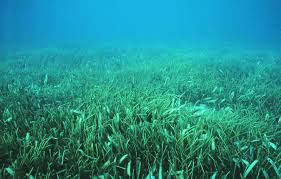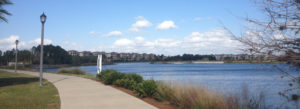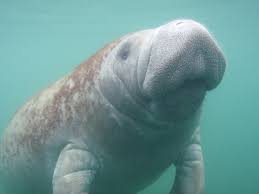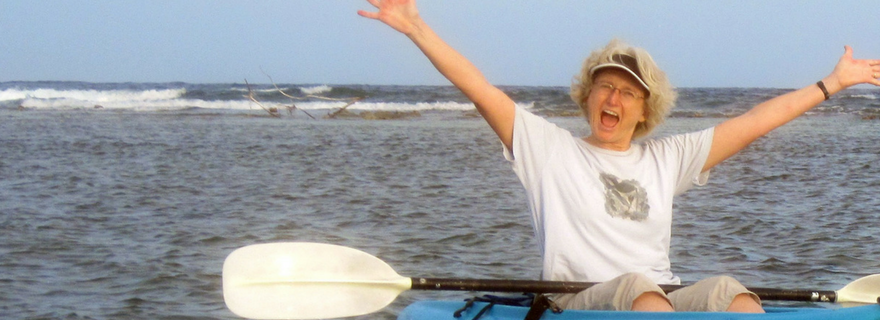[printfriendly]
What does the girl who grew up wanting to follow in the footsteps of Dr. Eugenie Clark (aka the Shark Lady) do when she retires?
Just like Clark, she keeps working – but as a volunteer for coastal management programs across the country rather than for a paycheck in Tampa Bay.
Holly Greening, the first scientist at the Tampa Bay Estuary Program and its second executive director, retires at the end of January after 27 years with TBEP. She joins Rich Batiuk, who led the science-based restoration of Chesapeake Bay, as co-founders of CoastWise Partners, offering to “work for (good) food” to help other coastal organizations succeed.

“We’re not ready to walk away from the work we love,” she says. “I’ll be in Oregon in February working with the Tillamook Estuaries Partnership on an organizational assessment ”
Ed Sherwood, senior scientist of the TBEP since 2008, steps into Greening’s role beginning February 1. “The immediate challenge for our region will be sustaining the great progress we have achieved in the bay’s restoration,” he said. “Continuing to build momentum and supporting a community of informed citizens who live, work and play in Tampa Bay will be my initial focus.”
Under Greening’s leadership, the bay is in the best shape it’s been in decades, notes Pinellas County Commissioner Charlie Justice, who also serves as chair of the TBEP’s Policy Committee. “She has been instrumental in bringing a variety of local governments and organizations together to bring about positive changes for Tampa Bay. We are confident that Ed Sherwood will continue her science-based approach to the decisions that have to be made for the next decade.”

For Stacy White, who was born and raised near Tampa Bay and now serves as a Hillsborough County commissioner and vice-chair of the TBEP Policy Board, “working with Holly has been an absolute pleasure. Tampa Bay is worth protecting for its sheer beauty, but it was brilliant of Holly to support the TBRPC study that shows its economic impact in terms of job creation for people who were still on the fence.”
In 2014, TBEP met its most important goal – regaining the 38,000 acres of seagrass beds lost after development in the 1960s and 1970s. “When we first set that goal in the mid-1990s, I ran the numbers and figured we might hit it in 2030 – long after I retired,” Greening notes. “It’s an amazing accomplishment for everyone in Tampa Bay that we achieved that very ambitious goal that much earlier than expected.”

Greening started her career in marine ecology in 1981 after earning a master’s degree from Florida State University literally underwater – studying food webs in the seagrasses off Big Bend. “We discovered that a lot of crabs and shrimp that are linked to fisheries hide during the day and tend to come out on the seagrass blades at night.”
While working for the University of Georgia in the Okefenokee Swamp, she discovered she was “not a bad organizer. I really liked getting together different groups working toward common goals from a lot of different angles.”
That’s come in handy at TBEP where she helped develop the technical basis for the organization’s first Comprehensive Conservation and Management Program in 1996 and then assisted with its recent 10-year revision released late last year. The CCMP update addresses ongoing challenges as well as emerging issues such as sea level rise and climate change, microplastics and the beneficial use of reclaimed water.
 “One of the things we spent a lot of time looking at was seagrass acreage,” she notes. “ Our goal was to bring the bay back to its 1950s level – but how clear should the water be to support that recovery? That made me think of a comment by Rich Paul (former Audubon Florida director of coastal islands sanctuaries) who pointed out in the early 1990s that removing too much nitrogen from the system may reduce the amount of phytoplankton that feeds small forage fish that, in turn, feed birds and larger fish. It made us all realize that finding a balance between water clarity that supports seagrass growth but also supports healthy phytoplankton was critical.
“One of the things we spent a lot of time looking at was seagrass acreage,” she notes. “ Our goal was to bring the bay back to its 1950s level – but how clear should the water be to support that recovery? That made me think of a comment by Rich Paul (former Audubon Florida director of coastal islands sanctuaries) who pointed out in the early 1990s that removing too much nitrogen from the system may reduce the amount of phytoplankton that feeds small forage fish that, in turn, feed birds and larger fish. It made us all realize that finding a balance between water clarity that supports seagrass growth but also supports healthy phytoplankton was critical.
Balance – across the board – is the focus of the new CCMP. “Restoring the Balance” – the long-time paradigm for ensuring that different habitats, from marshes and mangroves to salterns and seagrasses – is being reconsidered as temperatures continue to rise and habitats shift and adapt in response. “Just 50 years ago, mangroves were regularly knocked down by cold winters, but they’re much more prevalent than they used to be,” she notes. Salt marshes, on the other hand, have become less prevalent as mangroves have flourished.
Balancing ongoing population growth without increasing nutrient loadings will continue to be a priority. However, Tampa Bay has an advantage that many other estuaries do not. “The EPA and DEP (U.S. Environmental Protection Agency and Florida Department of Environmental Protection) have both accepted the limits the public/private Tampa Bay Nitrogen Management Consortium developed voluntarily and are implementing as adequate to meet water quality regulations. These limits on nitrogen loading will help ensure that Tampa Bay’s waters support a healthy ecosystem.”

It’s been a community-wide effort, she adds. “Collaboration has been the key to the success here because we’ve all worked together toward common goals of improving both the environment and the economy – more than 20% of the jobs in Tampa Bay depend upon a clean healthy bay.”
In the future, Greening expects to spend her time helping coastal communities reach their goals for improvement. She’ll also be traveling with her husband, Gerold, a retired biologist and you’ll also see them fishing, kayaking, sailing and volunteering with a nearby community garden. “I might even take up the classical guitar – I’ve wanted to do it since I was a teenager and this looks like a great time to try.”
She also expects to remain part of the TBEP family. “Dick (Eckenrod, TBEP’s first executive director) helped me to step from the scientific side of the estuary program to the policy side, and I started out standing on his shoulders. I’m hopeful that I’m leaving Ed with the same legacy and that Tampa Bay continues to improve even as our population grows. The Tampa Bay community has shown that collectively it can meet and surpass challenging goals to restore and protect the bay, and I look forward to continuing to be a part of that process.”
[su_divider]